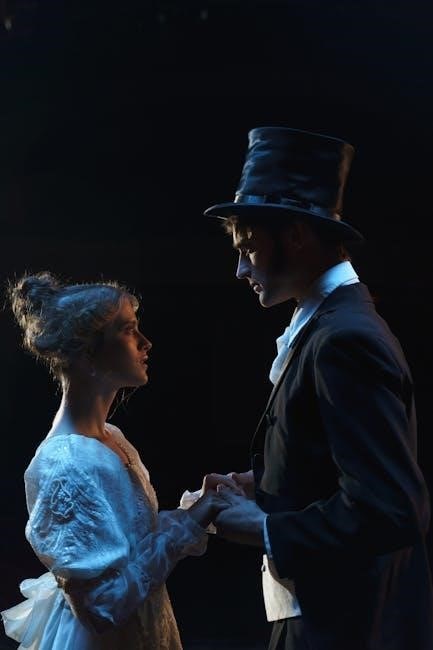Act 1 of The Crucible sets the stage in Salem, Massachusetts, 1692, introducing themes of hysteria, guilt, and deception amidst the witch trials, shaping the play’s dramatic tension.
1.1. Overview of the Play and Its Historical Context
The Crucible, written by Arthur Miller, is a dramatic portrayal of the Salem witch trials in 1692. Set against the backdrop of Puritan Massachusetts, the play explores themes of hysteria, guilt, and deception. Drawing from historical events, Miller critiques the dangers of mass hysteria and false accusations, reflecting both the paranoia of 17th-century Salem and the McCarthyism of his own era.
1.2. Importance of Act 1 in Setting the Tone
Act 1 of The Crucible is pivotal in establishing the play’s tone, introducing a tense atmosphere of fear, hysteria, and suspicion. Through the discovery of Betty’s illness and Abigail’s accusations, Miller sets the stage for escalating chaos. The act introduces key themes of guilt, deception, and the destructive power of unchecked emotions, creating a foreboding backdrop that foreshadows the tragic events to unfold.
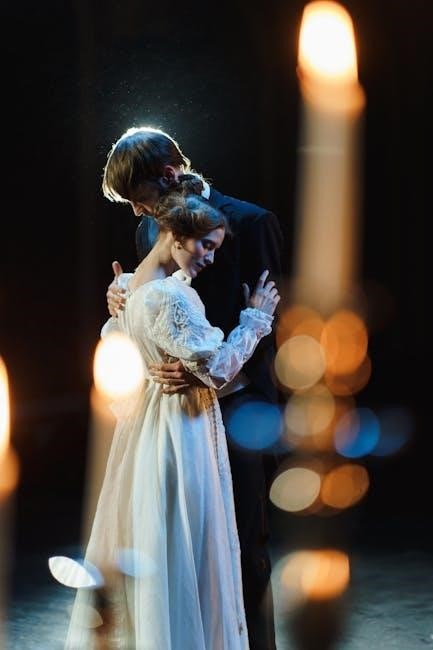
Setting of Act 1
Act 1 of The Crucible unfolds in Reverend Parris’s bedroom in Salem, Massachusetts, during the spring of 1692. The setting establishes a tense, foreboding atmosphere.
2.1. Time and Place: Salem, Massachusetts, 1692
The setting of Act 1 in The Crucible takes place in Salem, Massachusetts, during the spring of 1692. This period was marked by intense religious fervor and social tension, laying the groundwork for the witch trials. The Puritan community’s strict beliefs and fear of the unknown created an environment ripe for hysteria and accusation, central to the play’s conflict and themes.
2.2. Description of Reverend Parris’s Bedroom
Reverend Parris’s bedroom is a small, dimly lit upper room in his Salem home, reflecting the austerity of Puritan life. A narrow window allows morning sunlight, while a candle burns beside the bed where his daughter Betty lies ill. The sparse furnishings and somber atmosphere emphasize the gravity of the situation, setting a tense and foreboding tone for the unfolding drama.
2.3. The Atmosphere and Mood in the Opening Scene
The opening scene of The Crucible evokes a tense and foreboding atmosphere. The dimly lit bedroom, with a candle still burning, creates an air of unease and suspense. The morning sunlight streaming through the narrow window contrasts with the darkness of the situation, heightening the sense of impending doom. Fear and anxiety permeate the room, setting the stage for the hysteria and conflict that will unfold.
Main Characters Introduced in Act 1
Act 1 introduces key characters like Reverend Parris, Abigail Williams, Betty Parris, Mary Warren, and John Proctor, setting the foundation for their roles in the unfolding drama.
3.1. Reverend Samuel Parris
Reverend Samuel Parris, the town’s spiritual leader, is portrayed as a self-righteous and greedy man. His primary concerns are his reputation and material wealth, often prioritizing them over his daughter Betty’s well-being. His rigid beliefs and fear of losing social standing drive his actions, revealing a man more focused on appearances than genuine faith or compassion.
3.2; Abigail Williams
Abigail Williams is a manipulative and vengeful 17-year-old who serves as the catalyst for the witch trials. Driven by her past affair with John Proctor and his rejection, she harbors deep resentment. Her arrival in Parris’s house initiates the turmoil, showcasing her cunning nature and ability to exploit fear, ultimately leading to the devastating events that unfold in Salem.
3.3. Betty Parris
Betty Parris, the 10-year-old daughter of Reverend Parris, falls ill in Act 1, sparking fears of witchcraft. Her condition escalates the tension, as her father and others seek explanations, leading to the introduction of witchcraft suspicions. Her sickness becomes a central plot point, highlighting the hysteria and fear that dominate the community, setting the stage for the tragic events that follow in Salem.
3.4. Other Key Characters: Mary Warren, John Proctor
Mary Warren, the Proctors’ servant, is timid but morally conflicted, while John Proctor, a respected farmer, struggles with his past affair with Abigail, which later fuels her vengeance. Their interactions reveal underlying tensions and moral dilemmas, setting the stage for the play’s tragic progression and highlighting the personal and societal conflicts of 1692 Salem.
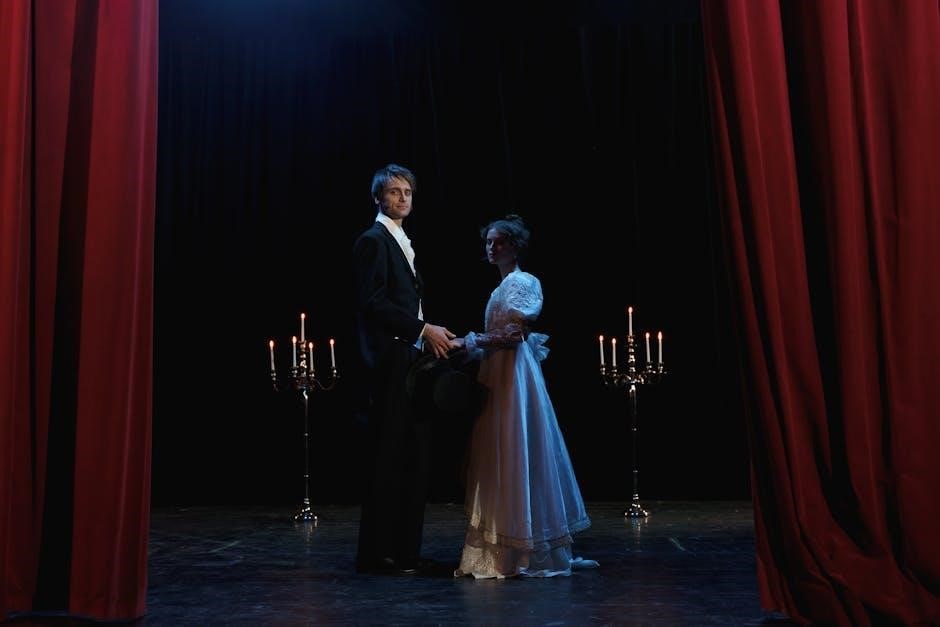
Major Events in Act 1
Betty’s mysterious illness sparks fear, Abigail’s manipulative nature emerges, witchcraft suspicions spread, and Reverend Hale arrives, intensifying the unfolding drama and setting the stage for chaos.
4.1. The Discovery of Betty’s Illness
The play opens with Reverend Parris discovering his daughter Betty’s mysterious illness, which sparks fear and suspicion. Betty, unresponsive and feverish, lies in bed, prompting Parris to seek spiritual and medical help. This event sets off a chain reaction, uncovering underlying tensions and superstitions within the Salem community, highlighting the fragile state of their society and the impending chaos.
4.2. Abigail’s Arrival and Her Conversation with Parris
Abigail Williams enters, initiating a tense conversation with her uncle, Reverend Parris. Her presence reveals underlying family conflicts and her own rebellious nature. Abigail’s dialogue exposes her resentment toward Parris and hints at her past relationship with John Proctor, setting the stage for future conflicts and deceit. This interaction underscores her manipulative tendencies and the simmering tensions within the household.
The discovery of Betty’s mysterious illness sparks fears of witchcraft, fueled by Abigail’s evasive explanations and the arrival of Reverend Hale. The community’s deep-seated paranoia and religious fervor escalate tensions, as accusations begin to surface. This section masterfully introduces the central conflict, blending superstition with the rigid societal norms of Salem, foreshadowing the chaos that will engulf the town.
4.4. The Arrival of Reverend Hale
Reverend Hale, an expert in witchcraft, arrives to investigate the strange occurrences. His presence elevates the tension, as he brings both authority and a systematic approach to uncovering the supposed evil. Hale’s methods and beliefs instill fear, setting the stage for the trials, while his character begins to reveal the complexities of a man grappling with his duties and conscience.
Themes and Motifs in Act 1
Act 1 introduces themes of fear, guilt, and deception, while motifs like light and darkness symbolize moral struggles. Religion’s influence and societal tensions are also explored.
5.1. Fear and Hysteria
Fear and hysteria dominate Act 1, fueled by Betty’s mysterious illness and the whispered suspicions of witchcraft. The eerie atmosphere in Parris’s bedroom escalates tension, as Abigail’s arrival and the community’s superstitions spread panic. This collective fear lays the groundwork for the chaos that follows, highlighting how unchecked emotions can lead to societal collapse and moral decay in Salem.
5.2. Guilt and Redemption
Guilt and redemption emerge through characters like Reverend Parris, haunted by his daughter’s illness and reputation fears; Abigail’s past sin with John Proctor fuels her manipulative actions, seeking redemption by shifting blame. The theme underscores how guilt can drive destructive behavior, while redemption remains elusive in Salem’s morally rigid society, highlighting the human struggle with conscience and forgiveness amidst chaos.
5.3. The Power of Lies and Deception
Lies and deception dominate Act 1, as Abigail’s false accusations and manipulation of others illustrate the destructive force of untruths. Her fabricated stories about witchcraft spread fear and hysteria, revealing how lies can escalate into chaos. The community’s gullibility and fear of retribution enable these deceptions, showcasing the devastating consequences of unchecked falsehoods in a rigid, suspicious society.
5.4. The Role of Religion in Society
In Act 1, religion permeates Salem’s oppressive society, with Reverend Parris embodying the rigid moral code. The community’s fear of God and the Devil fuels guilt and suspicion. Reverend Hale’s arrival intensifies the witch hunt, reflecting how religion can both guide and manipulate. This duality highlights the destructive potential of zealotry and the exploitation of faith in a frightened society.
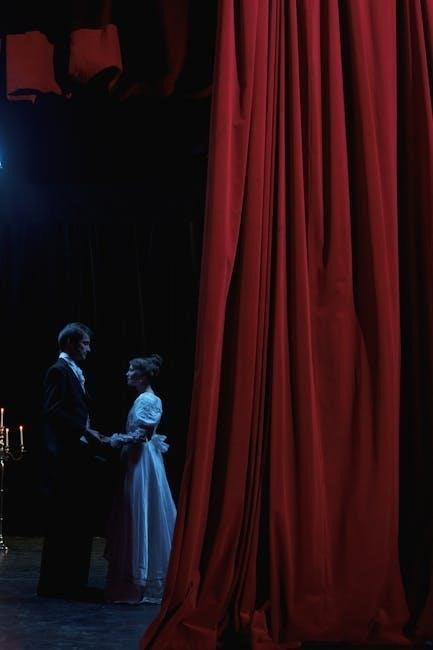
Key Quotes from Act 1
“You loved me, John Proctor, and whatever sin it is you love me yet!” ─ Abigail’s passionate declaration reveals her enduring feelings and guilt.
“If she is truly in the Devil’s grip, we may have to rip and tear to get her free.” ─ Reverend Hale’s words foreshadow the brutal methods of “healing.”
“Glory to God! It is broken, they are free!” ー Hale’s triumphant cry reflects the societal belief in divine intervention and communal redemption.
6.1. “You loved me, John Proctor, and whatever sin it is you love me yet!”
This quote, spoken by Abigail Williams, highlights her enduring passion for John Proctor and her refusal to accept the end of their affair. It reveals her emotional turmoil and the guilt she harbors, while also showcasing her manipulative nature. The line underscores the complex relationship between Abigail and John, setting the stage for the play’s tragic events.
6.2. “If she is truly in the Devil’s grip, we may have to rip and tear to get her free.”
This quote, spoken by Reverend Hale, reflects his determination to save Betty from suspected witchcraft. It highlights the Puritan belief in spiritual warfare and the extreme measures deemed necessary to rescue souls from the Devil’s influence. The statement underscores Hale’s role as a religious authority and sets the tone for the play’s themes of fear, hysteria, and the clash between faith and reality.
6.3. “Glory to God! It is broken, they are free!”
Reverend Hale exclaims this after Betty begins speaking, believing divine intervention has freed her from the Devil’s grasp. This moment highlights Hale’s spiritual conviction and the community’s desperation for salvation. The quote underscores the play’s themes of faith, redemption, and the blurred lines between divine will and human hysteria, foreshadowing the chaos that follows.
Historical Context Relevant to Act 1
Set during the Salem Witch Trials of 1692, Act 1 reflects the hysteria, fear, and religious extremism of Puritan society, shaping the play’s tense atmosphere and conflicts.
7.1. The Salem Witch Trials of 1692
The Salem Witch Trials were a series of events in 1692 where mass hysteria led to the execution of 20 individuals accused of witchcraft. The trials began with young girls accusing others of bewitchment, fueled by fear of the supernatural and rigid Puritan beliefs. This dark period highlighted societal tensions, paranoia, and the dangers of unchecked fear, creating a backdrop for Act 1’s dramatic events.
7.2. The Role of the Church in Salem Society
The church held immense power in Salem, dictating moral and legal standards. Reverend Parris’s influence exemplified its authority, shaping societal norms and suppressing dissent. The Puritan belief in a strict, vengeful God reinforced fear of the supernatural, creating a rigid, judgmental community. This religious dominance set the stage for Act 1’s events, where spiritual fear intertwined with accusation and control, fueling the witchcraft hysteria.
7.3. The Social and Political Tensions of the Time
Salem society in 1692 was marked by land disputes, class divisions, and political instability. The Puritan community’s strict social hierarchy and the church’s legal authority fueled tensions. Fear of outsiders and the supernatural, combined with economic rivalries, created an atmosphere of mistrust. These underlying conflicts escalated fears of witchcraft, transforming personal grievances into public accusations, as seen in Act 1’s unfolding events.
Literary Devices Used in Act 1
Miller employs symbolism, foreshadowing, and dramatic dialogue in Act 1 to highlight themes of guilt and deception, setting the tone for the tragic events that unfold.
8.1. Symbolism: The Use of Light and Darkness
In Act 1, Miller uses light and darkness as symbolic elements. The candle near Betty’s bed represents fragile hope and truth, while the morning sunlight symbolizes clarity and revelation. Darkness, however, signifies fear, ignorance, and the looming witch trials. This contrast underscores the moral and emotional struggles of the characters, foreshadowing theplay’s tragic outcomes and the blurred lines between good and evil.
8.2. Foreshadowing: Hints of Future Events
Act 1 employs foreshadowing to hint at the devastating events to come. Betty’s unexplained illness and the whispered fears of witchcraft suggest the chaos that will engulf Salem. Abigail’s vengeful nature and Proctor’s past affair are subtly introduced, hinting at the turmoil and tragic consequences that will unfold, setting the stage for the play’s exploration of hysteria, betrayal, and redemption.
8.3. Dialogue: Revealing Character Traits and Relationships
The dialogue in Act 1 skillfully reveals character traits and relationships. Parris’s anxious questions expose his self-serving nature, while Abigail’s assertive tone hints at her determination and hidden motives. Conversations between characters like Proctor and Abigail uncover their complex past, establishing tensions that drive the plot. Through dialogue, Miller masterfully unveils the moral struggles and interpersonal dynamics that fuel the play’s dramatic progression.
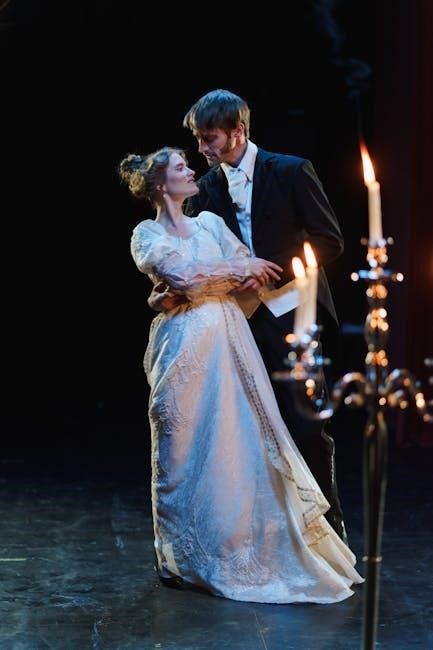
Themes and Motifs
Fear and hysteria dominate Act 1, intertwined with guilt and redemption, while the destructive power of deception and lies emerges as a central theme.
9.1. The Destruction of Innocence
Act 1 highlights the destruction of innocence through the manipulation of young characters like Betty and Abigail, whose vulnerability is exploited amidst the witch trials. Their youth and susceptibility to societal pressure lead to the erosion of their purity, as fear and hysteria overshadow reason, forcing them into roles they cannot comprehend. The adults’ failure to protect them accelerates this loss, marking the beginning of their tragic downfall.
9.2. The Dangers of Mass Hysteria
Act 1 illustrates how mass hysteria arises from fear and superstition, as Betty’s illness and Abigail’s accusations ignite a wave of panic in Salem. The community’s irrational behavior escalates, driven by unchecked emotions and the belief in supernatural forces. This collective madness highlights the destructive power of hysteria, leading to false accusations and the breakdown of rational judgment, ultimately threatening the entire community’s stability.
9.3. The Struggle for Justice and Morality
Act 1 portrays the struggle for justice and morality amidst Salem’s chaotic witch trials. Characters like John Proctor and Reverend Hale embody moral integrity, striving to uphold truth and fairness. However, the pervasive hysteria and fear-driven accusations undermine justice, revealing the tension between individual conscience and societal madness. This conflict sets the stage for the moral dilemmas that define the play.
The Role of Act 1 in the Overall Play
Act 1 lays the foundation for The Crucible, introducing key characters, conflicts, and themes that drive the narrative. It sets the tone for the tragic events unfolding.
10.1. Establishing Conflict and Tension
Act 1 of The Crucible masterfully establishes conflict and tension through the discovery of Betty’s mysterious illness, Abigail’s volatile arrival, and the introduction of witchcraft suspicions. These elements create a sense of impending doom, heightening the audience’s anticipation of the chaos to unfold. The tension is further amplified by the clash of personalities and the underlying fears of the Puritan community, setting the stage for the tragic events that follow.
10.2. Introducing Central Themes and Motifs
Act 1 introduces key themes such as fear, guilt, and deception, alongside motifs like light and darkness. The setting of Reverend Parris’s dimly lit bedroom contrasts with the morning sunlight, symbolizing the clash between truth and deception. These elements establish the moral and emotional framework, providing a foundation for exploring the destructive power of unchecked fear and the corrupting influence of power, central to the play’s narrative.
10.3. Setting the Stage for Tragic Events
Act 1 foreshadows the impending tragedy by revealing the fragile social fabric of Salem. The villagers’ deep-seated suspicions and the mysterious illness of Betty Parris ignite fears of witchcraft. The arrival of Reverend Hale signals the start of a chain reaction, setting in motion events that will lead to accusations, betrayals, and ultimately, devastating consequences for the community, as the seeds of destruction are sown early.
Study Resources for Act 1
Study resources for Act 1 include PDF guides, summaries, character analyses, and historical context. These materials provide background information, summaries, and study questions to aid understanding.
11.1. PDF Guides and Summaries
PDF guides and summaries for Act 1 of The Crucible are widely available online, offering detailed analyses, character summaries, and study questions. These resources provide background information on the play’s historical context, themes, and motifs, helping students grasp the complexities of the plot and characters. Many are free to download, making them accessible for deeper study and understanding of Arthur Miller’s work.
11.2. Character Analysis and Study Questions
Character analyses and study questions in Act 1 of The Crucible focus on understanding the motivations and conflicts of key figures like Reverend Parris, Abigail Williams, and John Proctor. These resources explore their roles in the unfolding drama, examining themes of guilt, deception, and hysteria. Study questions prompt readers to critically analyze character development and their impact on the play’s progression, fostering deeper engagement with the text.
11.3. Historical Context and Background Information
Act 1 of The Crucible is deeply rooted in the historical context of the Salem Witch Trials of 1692. The play reflects the societal tensions, religious fervor, and legal systems of the time. Miller’s portrayal of the trials highlights the hysteria and fear that led to the persecution of innocent people, offering insight into the tragic events that shaped Salem’s history and their enduring relevance today.
